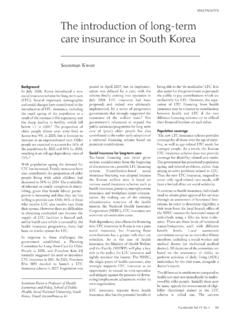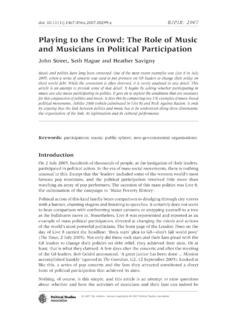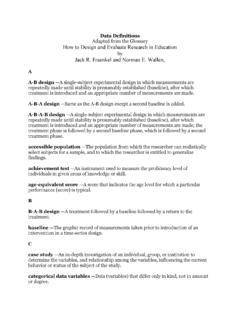Transcription of PROTOCOL - Comparative Efficacy of Statins 9Dec10
1 Comparative CLINICAL Efficacy OF Statins : A SYSTEMATIC REVIEW AND MIXED TREATMENT COMPARISON Huseyin Naci, Jasper J. Brugts, Rachael L. Fleurence, Bernice Tsoi, Harleen Toor, and Tony Ades STUDY PROTOCOL FINAL VERSION 9 December 2010 2 Primary Collaborators Huseyin Naci LSE Health Department of Social Policy London School of Economics & Political Science London, UK Dr. Jasper J. Brugts Department of Cardiology Erasmus MC Thoraxcenter Rotterdam, Netherlands Dr.
2 Rachael Fleurence Practice for Comparative Effectiveness Research United BioSource Corporation Chevy Chase, Maryland, USA Professor Tony Ades School of Social and Community Medicine Academic Unit of Primary Health Care University of Bristol Bristol, UK Systematic Review Contributors Bernice Tsoi Department of Social Policy London School of Economics & Political Science London, UK Harleen Toor Department of Social Policy London School of Economics & Political Science London, UK 3 Background Cardiovascular disease (CVD) is the leading cause of death and a major cause of disability In 2003, in the United States alone, CVD accounted for more than 800 thousand deaths.
3 It continues to be a major contributor to health disparities and rising health care costs. In 2006, the economic burden of CVD exceeded $400 Blood cholesterol levels are a strong predictor of mortality and morbidity associated with , 4 Statins act to lower blood cholesterol levels by inhibiting 3- hydroxy- 3- methylglutaryl coenzyme A (HMG CoA) reductase, an enzyme involved in cholesterol synthesis. Currently there are six Statins (atorvastatin, fluvastatin, lovastatin, pravastatin, rosuvastatin, simvastatin) marketed in the United States for the almost identical indication of reducing elevated total- cholesterol, low- density lipoprotein- C, apolipoprotein- B, non- high- density lipoprotein- C, and triglyceride levels and increasing high- density lipoprotein in patients with primary hypercholesterolemia.
4 5 Statins are used for the secondary prevention of cardiovascular events in patients with CVD (including a history of angina or acute myocardial infarction, peripheral arterial disease, or a history of stroke) and for primary prevention in patients who are at increased risk of cardiovascular events because of factors such as smoking, hypertension and diabetes. It is recommended that Statins are used in conjunction with lifestyle measures (diet, smoking cessation and exercise) and other appropriate interventions ( adequate control of chronic conditions such as hypertension and diabetes).
5 Statin therapy, initially focused on patients with established cardiovascular disease, has become widely common as the limits of treatment expanded over time to include persons at progressively lower risk of developing cardiovascular , 6 As the number of patients in need for statin therapy continues to increase, information regarding the relative clinical value of Statins is needed to better inform not only patients and prescribers, but also payers. It is particularly difficult to determine the exact threshold of the level of baseline risk for cardiovascular events at which to start prescription or tailor therapy to patients most likely to benefit from statin treatment.
6 A large body of literature has demonstrated the clinical Efficacy and safety of Statins for both primary and secondary prevention of CVD , 6- 12 There are three main limitations of the literature synthesizing the evidence on the Efficacy and safety of statin therapy: 4 1. The majority of published meta- analyses include only direct evidence. Based on a review of the literature, meta- analyses are largely pair- wise comparisons, often comparing Statins to placebo or conventional treatment group. Hence, they are often limited to placebo- controlled studies, with active- comparator trials only assessed in isolation.
7 This focus on placebo- controlled trials has limitations as there is a large number of active- comparator statin trials, which can contribute to the evidence base. It is therefore important to synthesize the totality of the evidence base on Statins . 2. The extent to which individual Statins differ in terms of Efficacy and acceptability is unclear. Although prescribers and guideline developers widely believe that similar drugs do not differ in terms of their clinical Efficacy , empirical evidence suggests that there may be differences between individual drugs in a , 14 A number of researchers suggested that assuming that all drugs with a similar mechanism of action are equivalent and can be used interchangeably may be clinically 17 With the basic mechanism of cholesterol lowering remaining the same.
8 The six Statins differ to a various extent in pharmacological properties and they may differ in terms of their clinical , 19 As with many drugs in so- called drug classes, the extent to which individual Statins vary in terms of Efficacy and acceptability is This is because of the fact that most randomized clinical trials have not tested different Statins head- to- head. Additionally, almost all of the meta- analyses lumped all Statins together as one , 7- 11, 21- 23 3. Quantitative syntheses of randomized trials have not taken into account the dose- response relationship of Statins .
9 The majority of published meta- analyses did not explicitly address the potential impact of dose on the clinical Efficacy and safety of Statins under the assumption that Statins at their respective doses have similar clinical Efficacy . This assumption cannot be validated and has not been verified in clinical data. Overcoming the limitations of the literature Combination of direct and indirect evidence: Methodological advances in statistical synthesis approaches, called mixed treatment comparisons (also known as network meta- analyses), facilitate 5 the combination of direct and indirect evidence by incorporating both direct (when Statins are compared to each other within a trial) and indirect comparisons (when Statins are compared between trials with a common comparator treatment, which is often placebo).
10 24- 26 Evaluation of the Comparative Efficacy and acceptability of individual Statins : By implication of including both direct and indirect evidence, attempts at statistically synthesizing the existing body of evidence are no longer limited to a pair- wise Rather, they are capable of comparing all relevant Statins even when they are not trialed against each Mixed treatment comparisons can summarize randomized trials of individual Statins to provide point estimates (together with uncertainty estimates) for their association with a given endpoint, as well as an estimate of incoherence (that is, a measure of how well the entire network of Statins fits together).

















